|
HOME
| TOC | ABOUT | UPDATES
| MAP | DISCLAIMER
| CONTACT | AWARDS
| LINKS
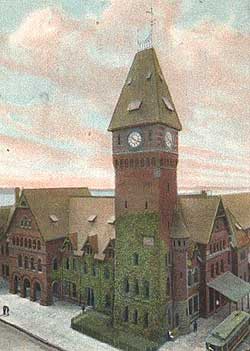 |
|
Old
MCS.
|
History
When the old Michigan Central Depot burned
on December 26, 1913 the still unfinished structure
off of Michigan Ave. was called into service. Designed
by noted hotel architects Warren & Wetmore and engineers
Reed and Stem, the MCS was an exceptionally beautiful
building. The style of choice was beaux-arts neoclassical.
Flanking massive arched windows were pairs of Corinthian
columns, a hallmark of the style. Inside the rooms were
modeled after an ancient Roman bathhouse, particularly
the massive main waiting room. With an impressive vaulted
ceiling this room was the most imposing in the building.
Smaller rooms for women and men were placed
at either end of the waiting room as were a cafe and
restaurant. Deeper into the station was a hall of massive
paired Doric columns. This area housed the ticket office
and a long shopping arcade. Beyond them one entered
another large space, the concourse. It was at the concourse
that one departed for their trains. The room was far
simpler then the waiting room, with walls of brick rather
then marble. But it featured a massive copper skylight.
From the concourse one passed through a similarly styled
ramp down into a long tunnel to the train platforms.
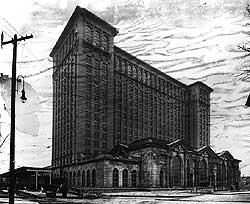 |
|
The
MCS prior to opening.
|
The station's most distinctive architectural
feature lay not inside but was the office tower rising
above the station proper. Rumored as a possible hotel,
it actually housed offices. The lower floors had marble
lined corridors while the upper floors were bare. The
top floor was never finished, its walls never being
plastered over. Architecturally this mass was joined
to the station with a band or pilasters running around
the upper floors. The total composition included 18
levels above ground. A massive basement level provided
facilities for baggage and mail.
When the station first opened automobiles
were still not common. Therefore the station was not,
nor would ever be, given decent parking facilities.
The intended main entrance was not the grand northern
entrance dominated with the three huge arches. Rather,
the most used entrance was intended to be the east entrance.
This was made so by the presence of a streetcar terminal
there. Because of the station's distance from downtown
it was thought that most passengers would arrive via
streetcar or interurban. They would exit the streetcar
at the terminal and then enter the station through the
east entrance. With the Depression came the end of the
interurban service and by 1938 the street cars were
gone. The station was suddenly isolated.
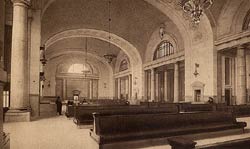 |
|
The
Waiting Room.
|
The station's isolation had not been a
great concern in 1913. It was believed that the presence
of a large station would cause the business district
to spread towards the area. This had been the case with
the Pennsylvania Station in New York. The slum in which
it had been built quickly transformed into one of the
city's finest retail addresses. Unfortunately, such
developments never took place for the MCS. During the
mid twenties, Henry Ford purchased land and planned
to build a large business center. However land values,
the General Moters-Fisher Building complex, and the
Great Depression put an end to these plans.
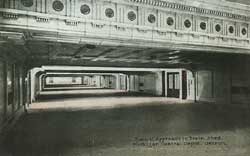 |
|
The
passenger tunnel.
|
The station thrived prior to the Second
World War. During the Second World War the rails were
crowded with military traffic and the MCS saw many tearful
good-byes as soldiers departed for the front. After
the Second World War, however, the slow decline began.
Automobiles gradually took over the Detroit-Chicago
route. The loss of passenger traffic become so bad that
by 1956 an attempt is made to sell the station for $5,000,000.
There were no buyers. Profits continued to decline and
by 1963 another attempt was made to sell the station,
once again there were no buyers. The station's decline
is made painfully obvious in 1967 when the main waiting
room and park entrance are closed due to declining passenger
traffic. Also facilities such as the arcade shops and
restaurant closed. Gradually the building deteriorated.
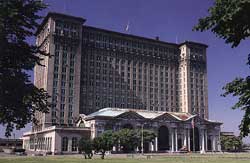 |
|
The
station towards the end.
|
In 1971 Amtrak took over the nations passenger
service. Once again things started to look bright for
the station. In 1975 the main entrance and waiting room
were reopened. Better yet, in 1978 $1,250,000 worth
of renovations begin. These include new track, bus facilities,
and cleaning. The offices were used by Conrail. These
bright days did not last. In 1984 the station was sold
for a transportation center that never materialized.
And then the unthinkable. Passenger traffic declined
so severely that the decision was made to close the
facility. On January 5, 1988 the last train departed.
The building was permanently closed later that day.
The building then started its quiet decay.
Open throughout much of the 90's, the
station has been vandalized. Its plaster and brass details
were gutted out by scavengers. Currently there has been
discussion of its renovation as the new Detroit Police
headquarters.
|